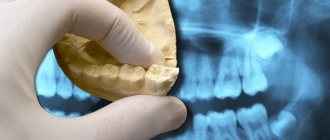Tonsillitis is an inflammation of areas of lymphoid tissue (tonsils) located on the back wall of the pharynx. They protect the body from the penetration of potentially dangerous viruses or bacteria, but in some cases they themselves can become infected. In many acute cases, the disease is viral in nature, so tonsillitis can be treated without the use of antibiotics. The chronic form of the disease is associated with the long-term existence of bacteria in the tonsil tissue. It requires complex therapy, and in some cases, surgical intervention. Tonsillitis most often affects children, but it can develop in people of any age.
Symptoms of tonsillitis
Signs of tonsillitis depend on its form and course. In the simple form, only local symptoms are observed. The toxic-allergic variant is accompanied by damage not only to the tonsils, but also to internal organs. Treatment of this form of chronic tonsillitis should begin as early as possible.
Possible symptoms of tonsillitis:
- sore throat, discomfort when swallowing, in young children food refusal is possible;
- signs of intoxication - fever, headache, weakness;
- redness, swelling of the tonsils, the appearance of white plaque or purulent plugs on them;
- hoarseness, cough, bad breath;
- abdominal pain, nausea and vomiting;
- enlargement and tenderness of the cervical lymph nodes;
- runny nose, red eyes, ear pain.
When the first symptoms of tonsillitis appear, you should consult a doctor, as this disease can become chronic or cause complications in the internal organs.
All about tonsillitis
Tonsillitis
Tonsillitis is an inflammation of the pharyngeal and palatine tonsils at the back of the throat. This disease mainly affects children, but both teenagers and adults can get it.
Symptoms
Tonsillitis can feel like a bad cold or flu, and the tonsils at the back of your throat will be red and swollen.
The main symptoms in children and adults are:
- a sore throat
- problems with swallowing
- high temperature 38°C or higher
- cough
- headache
- feeling of nausea
- ear pain
- feeling tired
Sometimes symptoms can be more severe and include:
- Swollen lymph nodes in the neck (feels like a lump on the side of the neck)
- white pus-filled spots on your tonsils
- bad breath
Causes
Viral infections cause 40 to 60% of tonsillitis cases. Many viruses can cause inflammation of the tonsils (and the rest of the throat), including adenovirus, rhinovirus, coronavirus, influenza virus, parainfluenza virus, coxsackie virus, measles virus, Epstein-Barr virus, cytomegalovirus, respiratory syncytial virus, and herpes simplex virus. Tonsillitis may also be part of the initial reaction to HIV infection. It is estimated that 1 to 10% of cases are caused by the Epstein-Barr virus.
Tonsillitis can also be caused by infection with bacteria, primarily group A β-hemolytic streptococci (GABHS), which cause a sore throat. A bacterial infection of the tonsils usually follows an initial viral infection. When tonsillitis recurs after antibiotic treatment for streptococcal bacteria, it is usually due to the same bacteria as the first time, indicating that the antibiotic treatment was not completely effective.
Inside the tonsils, white blood cells from the immune system destroy viruses or bacteria by producing inflammatory cytokines, which also lead to fever. The infection may also be present in the throat and surrounding areas, causing inflammation of the pharynx.
Diagnostics
There is no clear distinction between a sore throat that is specific to tonsillitis and a sore throat caused by inflammation in both the tonsils and nearby tissues. Acute sore throat may be diagnosed as tonsillitis, pharyngitis, or tonsillopharyngitis (also called pharyngotonsillitis), depending on clinical findings.
Throat swab.
In primary care settings, the Centor criteria are used to determine the likelihood of group A beta-hemolytic streptococcus (GABHS) infection in acute tonsillitis and the need for antibiotics to treat tonsillitis
If the rapid test for streptococcus is negative, a bacterial culture may be required.
Nasoendoscopy may be used for those with severe neck pain and inability to swallow any liquids to rule out occult epiglottis and supraglottis. Conventional nasoendoscopy is not recommended for children.
Treatment
Treatments to reduce discomfort from tonsillitis include:
- pain relievers and fever reducers such as paracetamol (acetaminophen) and ibuprofen
- rinse with warm salt water, lozenges, honey or warm liquids
Antibiotics
If tonsillitis is caused by group A streptococcus, antibiotics are helpful, with penicillin or amoxicillin being the main choices.
Cephalosporins and macrolides are considered good alternatives to penicillin in the emergency setting. A macrolide, such as azithromycin or erythromycin, is used for people who are allergic to penicillin. If penicillin therapy does not help, bacterial tonsillitis may respond to treatments that are effective against beta-lactamase-producing bacteria, such as clindamycin or amoxicillin-clavulanate. Treatment with antibiotics is usually carried out for seven to ten days.
Painkillers
Paracetamol and non-steroidal anti-inflammatory drugs (NSAIDs) can be used to treat sore throat in children and adults. NSAIDs (such as ibuprofen) and opioids (such as codeine and tramadol) are equally effective for pain relief, but precautions should be taken with these pain medications. NSAIDs can cause peptic ulcers and kidney damage. An anesthetic mouth rinse may also be used to relieve symptoms.
Surgery
When tonsillitis recurs frequently, at least five times a year, or when the tonsils become so swollen that swallowing is difficult and painful, a tonsillectomy may be performed to surgically remove the tonsils.
Prevention
The microbes that cause viral and bacterial tonsillitis are contagious. Therefore, the best prevention is to follow the rules of hygiene.
- Wash your hands thoroughly and often, especially after using the toilet and before eating
- Avoid sharing food, drinking glasses, water bottles, or utensils
- Change your toothbrush after you are diagnosed with tonsillitis
Sources
" Tonsillitis " , UK National Health Service
https://www.nhs.uk/conditions/tonsillitis/
"Tonsillopharyngitis" , World Medical Directory "The Merck Manuals",
https://www.msdmanuals.com/professional/ear,-nose,-and-throat-disorders/oral-and-pharyngeal-disorders/tonsillopharyngitis?query=tonsillitis
"Tonsillitis" , Mayo Foundation for Medical Education and Research (MFMER).
https://www.mayoclinic.org/diseases-conditions/tonsillitis/symptoms-causes/syc-20378479
Causes
Tonsillitis is an infectious disease. It can be caused by various types of viruses:
- adenovirus, enterovirus, influenza and parainfluenza viruses;
- Epstein-Barr virus, cytomegalovirus infection;
- pathogens of measles, herpes simplex and others.
Bacterial tonsillitis is most often caused by streptococci. It can also be caused by staphylococci, gonococci, corynebacterium diphtheria, anaerobic flora, and spirochetes. Candida sore throat sometimes occurs in young children.
The development of the disease also involves factors that reduce the overall resistance of the body - hypothermia, malnutrition, prolonged emotional stress and others.
Treatment for tonsillitis depends on its causes. To determine the causative agent, timely consultation with a doctor is necessary.
Operations for tonsillitis: from traditional methods to modern techniques
Indications for surgical treatment:
- The presence of episodes of exacerbation of the disease 2 or more times a year, with a predominance of purulent inflammation.
- Frequent (more than 4 times a year) exacerbations of tonsillitis, even if they occur without complications.
- Exacerbations are rare, but there are signs of complications from the heart, joints, kidneys or other organs.
- The disease is latent (hidden), but has become the cause of the development of rheumatism and other systemic diseases.
For a long time it was believed that chronically inflamed tonsils should be completely removed. This operation is called tonsillectomy. It allows you to eliminate the source of infection, but makes an uncorrectable hole in the protective lymphoid ring of the pharynx.
Currently, tonsillectomy is rarely performed, mainly in cases of severe purulent-destructive changes in the tonsils. In all other cases, ENT doctors give preference to organ-preserving operations, trying to leave an island of functionally active tonsil tissue.
But resection (partial cutting off of the tonsils) carries the risk of relapse of the disease. After all, such a procedure does not guarantee the elimination of all inflamed and infected tissue. The use of a laser improves the result due to an additional disinfecting and immunomodulating effect in the surgical area, but still does not completely solve the problem of relapses. Nevertheless, laser technologies are recognized as a priority in the treatment of tonsillitis.
Classification of tonsillitis
The disease can be acute or chronic. In the first case, signs of infection disappear within 7 to 10 days. In a chronic course, pathogens remain in the tissues of the tonsils, causing periodic exacerbations. Treatment of chronic tonsillitis is a complex task that only experienced otolaryngologists can handle.
Chronic tonsillitis has 2 forms - simple and toxic-allergic. In the latter case, there are 2 degrees of severity of pathological changes.
The simple form is characterized by only local symptoms. With the toxic-allergic variant, the following pathological processes occur:
- microbial toxins that enter the blood cause sensitization (altered reactivity) of the body;
- they act directly on the tissues of internal organs;
- toxins also lead to the development of allergic and autoimmune reactions.
To treat tonsillitis in this case, a complex effect on the entire body is necessary.
Why treat chronic tonsillitis?
Chronically inflamed tonsils become a constant source of infection. With a decrease in immunity, it can spread to other tonsils and peripharyngeal tissue, invade the nasal cavity and paranasal sinuses, and descend into the underlying parts of the respiratory tract.
But the inflammatory reaction of the tonsils is not the main problem of chronic tonsillitis. Constant irritation of the immune forces not only weakens the protective response, but also creates the preconditions for the occurrence of abnormal reactions. Antibodies appear in the body, which are initially produced against β-hemolytic streptococcus, but show aggression towards connective tissue.
This secondary pathology is called rheumatism or Sokolsky-Buyo disease. It is a systemic acquired disease with an autoimmune mechanism, with the favorite targets for antibodies being heart valves and the synovium of small joints.
The key focus of streptococcal infection and the site of primary formation of rheumatic autoantibodies is the inflamed tonsils. Therefore, competent treatment of chronic tonsillitis is an effective prevention of rheumatism and its complications.
Acute form
Sore throat, or acute tonsillitis, begins suddenly with an increase in temperature and the appearance of signs of intoxication. It has several clinical forms:
- catarrhal: redness and swelling of the tonsils, arches, soft palate;
- follicular: round or fuzzy white-yellow dots appear on the surface of the tonsils, caused by inflammation of the lymphoid follicles;
- lacunar: a light coating appears in the recesses of the tonsils, which covers their surface in the form of islands;
- fibrinous: purulent plaque lines the entire surface of the tonsils, an unpleasant odor appears from the patient’s mouth;
- phlegmonous: the formation of purulent foci (abscesses) inside the tonsil, which causes a sharp pain in the throat, the inability to move the head, and deterioration of the general condition.
The development of severe forms of the disease is usually associated with untimely or improper treatment of tonsillitis.
Anatomy of the throat
In the pharynx, on the sides and along the back wall, as well as on the border of the oral and nasal cavities, there are accumulations of lymphoid tissue - the so-called lymphoid-pharyngeal ring. It performs a protective function, and each of the tonsils of this ring is an important organ of our immunity.
The largest accumulations of lymphoid tissue are called tonsils (they are also called tonsils ) and there are several of them: two palatine, two tubal, one pharyngeal (aka adenoid) and one lingual.
Inflammation of the palatine tonsils (in everyday life they are called tonsils) is called acute tonsillitis or tonsillitis .
Chronic form of tonsillitis
Chronic tonsillitis is characterized by repeated recurrence of tonsillitis. A long-lasting focus of infection forms in the palatine tonsils. This leads to a deterioration in the general condition:
- the patient experiences a constant or periodic increase in body temperature;
- the patient complains of fatigue, decreased mental and physical performance, sweating;
- Headaches, sleep and appetite disturbances are noted.
In the simple form of the disease, there is redness, enlargement of the tonsils and palatine arches, their fusion, and enlargement of the lymph nodes.
The toxic-allergic form is accompanied by damage to internal organs. In grade I, changes in the general condition, heart, joints, enlarged lymph nodes, and laboratory abnormalities are not constant. II degree of severity is accompanied by the following disorders:
- pain in the heart area, rapid heartbeat, heart rhythm disturbances, changes in the ECG;
- joint pain, which occurs not only during an exacerbation, but also during remission;
- prolonged increase in body temperature to subfebrile levels;
- changes in the functioning of the liver, kidneys and other organs, manifested by corresponding symptoms and changes in laboratory data.
Chronic tonsillitis is part of the pathogenesis of many other diseases - rheumatism, polyarthritis, glomerulonephritis, sepsis, pathology of connective tissue, endocrine, nervous, and digestive systems.
Development mechanism and reasons
The palatine tonsils, or tonsils, along with the lymphoid structures of the oropharynx, perform the function of protection against pathogenic microorganisms and viruses. When local immunity decreases or the number of pathogen colonies increases, an exacerbation occurs - acute tonsillitis.
Recurrent tonsillitis leads to chronic tonsillitis. It is extremely rare that chronicity of the disease occurs after primary inflammation, and also without previous sore throats.
More than 30 pathogenic microorganisms can provoke tonsillitis, but staphylococcus and streptococcal infections are most often detected. The main role is played by the activity of streptococcus. Other microorganisms contribute more to reducing local immunity and maintaining the inflammatory process.
Provoking factors:
- past infections;
- immunodeficiencies, including those caused by immunosuppressive therapy;
- hypothermia;
- seasonal allergies;
- adenoiditis;
- inflammatory foci in neighboring sections;
- polyps and others.
Chronic angina is promoted by improper or incomplete treatment of the acute form of the disease, self-medication and unjustified symptomatic therapy.
Complications of tonsillitis
Tonsillitis, both acute and chronic, can cause local and general complications.
The first group includes damage to the tissues of the pharynx: paratonsillar abscess, parapharyngitis, laryngitis. Local complications also include acute otitis media and cervical lymphadenitis.
Common complications associated with damage to internal organs:
- diseases of the joints and connective tissue: rheumatism, rheumatoid arthritis, infectious polyarthritis, systemic lupus erythematosus;
- damage to the heart and mediastinum: myocarditis with the development of dilated cardiomyopathy and heart failure, mediastinitis;
- inflammation of the lungs, kidneys, appendix, sepsis and others.
To avoid the development of such complications, if there are symptoms of tonsillitis, it is necessary to carry out its full treatment.
Treatment without surgery
Conservative treatment includes general and local drug therapy, physiotherapy, lavage of lacunae and other methods of cleansing the tonsils. Antibacterial, anti-inflammatory, antiallergic, and immunomodulatory agents are prescribed.
Conservative therapy is widely used in modern otorhinolaryngology. But it does not always completely cure tonsillitis. The tonsils may remain enlarged even after drug suppression of the infection and deep cleansing; the risk of relapses and complications remains. In approximately 1/3 of patients, it becomes necessary to treat the disease surgically.
Diagnostics
Recognition of acute or chronic forms of the disease is based on the following diagnostic data:
- enlargement and possible soreness of the submandibular and cervical lymph nodes;
- swelling, redness of the tonsils and arches, their inflammatory infiltration;
- discharge of purulent contents when pressing with a spatula on the surface of the tonsils.
To diagnose lesions of other organs, laboratory tests, ECG, radiography of the paranasal sinuses and other studies are used.
Possible complications of tonsillitis
- Rheumatism is the most dangerous complication, which, in turn, can affect the joints and lead to heart disease.
- Pyelonephritis.
- Peritonsillitis, peritonsillar abscess.
Causes of sore throat:
- various viruses;
- bacteria;
- hypothermia of the body;
- decreased immune system functions;
- tonsil injury;
- violation of nasal breathing;
- various inflammations in the oral cavity.
Causes of chronic tonsillitis:
- frequent sore throats and ARVI;
- diseases of teeth and gums;
- nasal breathing disorder.
- weakened immune system;
- presence of allergies.
Types of treatment for tonsillitis
Treatment of acute tonsillitis is carried out taking into account its cause. For bacterial sore throat, antibiotics are prescribed. Anti-inflammatory, antipyretic, painkillers, and gargling with antiseptic solutions are used.
Treatment of chronic tonsillitis includes external therapy, tonsil lavage, physiotherapy, and surgery.
Treating tonsillitis at home
During the period of remission of the disease, the following means can be used to mechanically remove pathogens and increase the body’s reactivity:
- applying a mixture of aloe juice (1 part) and honey (3 parts) to the tonsils;
- gargling with infusions of medicinal herbs (chamomile, yarrow, St. John's wort, linden blossom, garlic, eucalyptus);
- using propolis in the form of pieces or ingesting a solution of propolis in warm milk.
Drug treatment of tonsillitis
Conservative therapy is prescribed for acute tonsillitis (angina), exacerbation of a chronic process. Antibacterial drugs and symptomatic agents are prescribed.
During the period of remission, courses of washing the tonsils lasting 10 days are indicated 2-3 times a year. Such treatment is carried out using the “Tonsillor” or “Utes” devices. The lacunae are washed with solutions of antiseptics and immunostimulants - interferon, levamisole, lysozyme and others. After washing, the surface of the tonsils is treated with Lugol's solution or collargol.
A course of irradiation with a helium-neon laser or low-intensity incoherent red light, ultraviolet irradiation, ultrasound therapy, UHF and other physiotherapeutic techniques are used.
Such treatment cannot completely relieve the patient of tonsillitis. It only helps to reduce the frequency of exacerbations and reduce the risk of complications of the disease. If conservative methods are ineffective within 1–2 years, surgical intervention is indicated.
How to treat acute tonsillitis
Treatment of acute tonsillitis or tonsillitis depends on the pathogen and the severity of the disease.
1. If we are talking about bacterial infection, then it is necessary to prescribe antibacterial drugs of different groups.
Only a doctor can prescribe an effective antibiotic!
Antibiotics are not effective against viral tonsillitis.
2. Symptomatic treatment:
Includes taking antipyretics, painkillers, as well as the use of local anti-inflammatory and antimicrobial drugs in the form of solutions, lozenges, tablets.
3. A gentle diet. Namely, the exclusion of spicy, fried, and sour foods will help reduce irritation to the inflamed tissues of the throat.
4. If treatment is ineffective or complications occur, hospitalization is indicated. In the hospital, the patient will be under the close attention of doctors, blood tests will be monitored, and hormonal and anti-inflammatory drugs may be administered. It is possible to use systemic antibiotics in the form of tablets or intravenously or intramuscularly.
If necessary, surgical intervention is performed.
Regardless of the severity of the disease, pathogen and form, treatment must be comprehensive, that is, have an antimicrobial, anti-inflammatory and analgesic effect. Uncontrolled treatment with folk remedies can only do harm.
Causes, main risk factors
Up to 30 different colonies of pathogenic microbes can be sown on the surface of the tonsils of patients suffering from chronic tonsillitis. But in crypts and lacunae staphylo- or streptococcus is usually determined. A key role in the pathogenesis of chronic tonsillitis is played by beta-hemolytic strains of streptococcus (type A). Other flora - gram-negative coccal, fungal, viral - have an impact on local immunity, they support inflammation.
There are a number of factors contributing to the occurrence of the disease:
- hypothermia;
- decreased immunity;
- microtrauma of the tonsils;
- foci of inflammation in the mouth and in the head area (caries, sinusitis, adenoids, etc.);
- smoking;
- poor nutrition;
- allergy.
Viruses and bacteria that cause tonsillitis can come from the external environment.
Conservative therapy
Depending on the diagnostic results, the doctor draws up an individual treatment plan. Acute tonsillitis is treated by a therapist on an outpatient basis using conservative methods, using antibacterial drugs in the form of tablets, rinsing, washing, and irrigation of tonsil lacunae.
Therapy of chronic tonsillitis is the responsibility of an otolaryngologist, who acts together with an immunologist.
A good result in the treatment of the disease is achieved by affecting the tonsils themselves. The hospital's otolaryngologists conduct courses of medical manipulations, during which:
- caseous plugs are removed;
- The folds of the tonsils (lacunae), which hide foci of infection, are cleaned.
During the treatment process - washing, lubricating and irrigating the tonsils with medicinal solutions, inflammation is stopped, the compensatory stage of the disease is prolonged, which makes it possible to delay or avoid tonsillectomy. Additionally, complex treatment at home is prescribed.
Reviews
Andrey
For most of my life I was tormented by constant exacerbations of chronic tonsillitis. Every spring and autumn I consistently lost two weeks for treatment. Surgery to remove tonsils has bothered me since childhood. My wife almost forcibly brought me to the clinic. I didn’t even imagine that new techniques can eliminate the problem absolutely painlessly. I have been living without constant exacerbations for a year now, and I am very grateful to the hospital specialists for this.
Natalia
Not long ago I had to bring my child to have his tonsils removed. From my own experience I remember how unpleasant and painful this procedure is. I was more worried than my son. However, the clinic doctors were able to find an approach to the child and calm him down. The operation was performed without pain or blood. Now I know for sure that your clinic employs super specialists and kind, sympathetic people.
Why is tonsillitis dangerous?
Chronic tonsillitis is very dangerous: if you do not consult a specialist in a timely manner and self-medicate, complications may develop, among which the most dangerous are diseases of the heart and blood vessels, and rheumatic joint damage.
Tonsillitis in adults often leads to damage to the kidneys ( tonsillorenal syndrome ) and heart ( tonsillocardiac syndrome ). This is due to the fact that infectious and toxic factors that damage internal organs enter the body from the palatine tonsils. Streptococcus, for example, secretes a toxin, the effects of which can cause myocardial dystrophy and heart disease or rheumatism . In addition, purulent contents entering the gastrointestinal tract from the lacunae of the tonsils can provoke dysbacteriosis.
Treatment
There are two main methods of treatment: surgical and conservative.
The treatment method is determined by an otorhinolaryngologist, which depends on:
- forms of chronic inflammation;
- frequency of exacerbations;
- the presence or absence of beta-hemolytic streptococcus in the tonsils;
- effectiveness of previous therapy.
Conservative treatment method:
- Local antibiotic therapy
- Systemic antibiotic therapy (tablet or injection forms).
- Rinsing the lacunae of the tonsils and introducing antibacterial and anti-inflammatory drugs into them.
- Physiotherapeutic procedures:
- phonophoresis of drugs,
- ultraviolet radiation (UV),
- magnetic laser therapy (MILTA),
- vibroacoustic impact.
Classification
| Simple form Characteristic: the course of the disease with local symptoms, subjective complaints and objective signs of the disease, with frequent sore throats, and in other cases - without repeated sore throats (“anginless” chronic tonsillitis). | Toxicallergic form Characterized by: low-grade fever, phenomena of tonsillogenic intoxication, manifestations of tonsillocardiac syndrome. |
Surgery
If no conservative treatment methods lead to a lasting therapeutic effect, the doctor recommends surgical treatment: tonsillotomy or tonsillectomy.
The hospital practices both of these types of tonsil removal:
- tonsillotomy - partial removal of the tonsils in children aged 3-12 years while preserving the protective functions of the lymphoid tissue that make up the tonsils;
- Tonsillectomy - complete removal of the tonsils, is used when the tonsils are pathologically changed and are a source of chronic infection, or when complications arise from the organs, blood vessels, and joints of the body.
At the Yauza Clinical Hospital, all types of operations to remove tonsils are performed under anesthesia. In the process of tonsillectomy, a bipolar coagulator is used, which minimizes trauma to surrounding tissues and allows almost completely to avoid blood loss due to coagulation of the vessels feeding the tissue.
The Clinical Hospital on Yauza uses modern technology for tonsillectomy with suturing of the wound surface. The innovative tonsillectomy technique allows:
- minimize the risk of bleeding in the postoperative period;
- significantly speed up the postoperative healing period;
- reduce the rehabilitation period: hospital stay - up to a day; restoration of working capacity - after 7-10 days.
The cost of tonsillectomy is calculated for each patient separately and depends on the diagnostic examination, surgical method, and length of hospital stay.
At the Clinical Hospital on Yauza you are guaranteed:
- strict adherence to the treatment protocol;
- examination in a laboratory equipped with the latest advances in medical science;
- conservative treatment and tonsillectomy using the most effective technologies and using innovative equipment;
- stay in a comfortable room;
- constant supervision of experienced practitioners.
For any manifestations of tonsillitis, contact the Clinical Hospital on Yauza through the website by filling out the online appointment form.
You can see prices for services
Prerequisites for the development of tonsillitis
The palatine tonsils, nasopharyngeal tonsil, lingual and tubal tonsils form a protective ring (lymphoepithelial ring of Pirogov) - a powerful barrier to the air and food entering the body. The tonsils do a great job - they recognize dangerous viruses and bacteria in the air and food and trigger an immune reaction.
When examining the tonsil on its surface, you can see depressions and openings with narrow, winding and deep passages (the so-called tonsil lacunae).
| 1 - crypt (lacuna); 2 - lymphoid follicles; 3 - connective tissue capsule; 4 - mouth of the lacuna (crypt). | |
The existence of deep lacunae creates the prerequisites for the development of chronic inflammation of the tonsils. Remains of food, dead immune cells, etc. settle in the gaps, which are an excellent breeding ground for the proliferation of pathogenic microorganisms.








